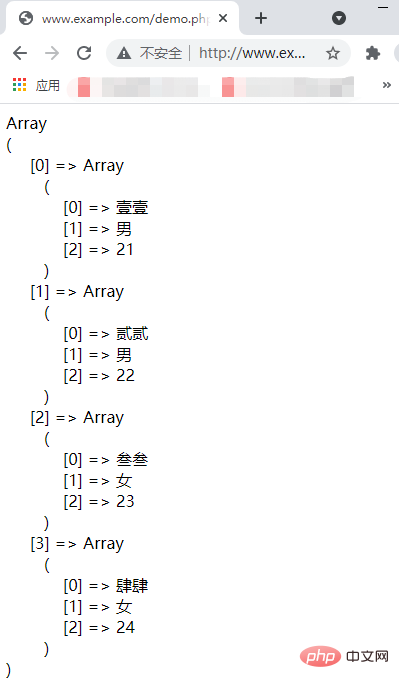Usage of mysqli_select_db and mysqli_query functions in PHP
In the previous article, I brought you "How to connect to the MySQL database in PHP? ", which introduces in detail how to connect to the MySQL database in PHP. In this article, we take a look at the relevant knowledge of PHP using the mysqli_select_db() function to select a database. I hope everyone has to help!

As mentioned in the previous article, PHP can connect to the MySQL database through the mysqli_connect() function. One parameter of this function is the name of the corresponding database. , this parameter is an optional parameter and can be omitted. If you omit this parameter, you need to specify a default database later. In PHP, you can specify a default database through the mysqli_select_db() function. Then let’s take a look at the usage of this function.
<strong><span style="font-size: 20px;">mysqli_select_db()</span></strong>Function
The syntax of this function The format is also divided into two situations. One is the object-oriented writing method, and its syntax format is as follows:
mysqli::select_db(string $dbname)
where $dbname represents the specified database name, and the other The first is a process-oriented writing method, and its syntax format is as follows:
mysqli_select_db(mysqli $link, string $dbname)
It should be noted that:
$dbnameis still expressed as specified Database name,$linkrepresents the database connection returned by the mysqli_connect() function.
If the function is successfully executed, the return result is true. If the function fails, the return result is false.
Next, let’s take an example to see how to select a database through the mysqli_select_db() function. The example is as follows:
<?php
$host = 'localhost';
$username = 'root';
$password = 'root';
$dbname = 'test';
$mysql = new Mysqli($host, $username, $password);
if($mysql -> connect_errno){
die('数据库连接失败:'.$mysql->connect_errno);
}else{
$mysql -> select_db($dbname); // 选择名为 test 的数据库
$sql = 'select name,sex,age from user'; // SQL 语句
$result = $mysql -> query($sql); // 执行上面的 SQL 语句
$data = $result -> fetch_all();
$mysql -> close();
}
echo '<pre class="brush:php;toolbar:false">';
print_r($data);
?>The above example selects a database named “test” through the mysqli_select_db() function. ” database, the output results are as follows:

The above example uses object-oriented writing. Next, let’s take a look at what process-oriented writing looks like. Example As follows:
<?php
$host = 'localhost';
$username = 'root';
$password = 'root';
$dbname = 'test';
$link = @mysqli_connect($host, $username, $password);
if($link){
mysqli_select_db($link, $dbname); // 选择名为 test 的数据库
$sql = 'select name,sex,age from user'; // SQL 语句
$result = mysqli_query($link, $sql); // 执行 SQL 语句,并返回结果
$data = mysqli_fetch_all($result); // 从结果集中获取所有数据
mysqli_close($link);
}else{
echo '数据库连接失败!';
}
echo '<pre class="brush:php;toolbar:false">';
print_r($data);
?>In the above example, the difference between the two writing methods is not big, and the output results are the same. From this we specify a default database through the mysqli_select_db() function. Then let's take a look at the mysqli_query() function. What does it do and how is it used?
<strong><span style="font-size: 20px;">mysqli_query()</span></strong>## Function
mysqli_query() function. The syntax format of this function is as follows:
mysqli::query( string $query [, int $resultmode = MYSQLI_STORE_RESULT ] )
$query
represents the SQL statement to be executed;$resultmode
is an optional parameter, used to modify the behavior of the function.
mysqli_query( mysqli $link , string $query [, int $resultmode = MYSQLI_STORE_RESULT ] )
$link
Represents the database connection returned by the mysqli_connect() function;$query
Represents the SQL statement to be executed;$resultmode
is an optional parameter used to modify the behavior of the function.
mysql> select * from user;First of all, let’s take a look at the object-oriented writing method. The example is as follows :---- -------- ------ ------
| id | name | age | sex |
---- -------- ------ ------
| 1 | 一一 | 21 | Male |
| 2 | 二二 | 22 | Male |
| 3 | Sansan | 23 | Female |
| 4 | Four Four | 24 | Female |
---- --- ----- ------ ------
4 rows in set (0.00 sec)
<?php
$host = 'localhost';
$username = 'root';
$password = 'root';
$dbname = 'test';
$mysql = new Mysqli($host, $username, $password, $dbname);
if($mysql -> connect_errno){
die('数据库连接失败:'.$mysql->connect_errno);
}else{
$mysql -> set_charset('UTF-8'); // 设置数据库字符集
$sql = 'select name,sex,age from user'; // SQL 语句
$result = $mysql -> query($sql); // 执行上面的 SQL 语句
$data = $result -> fetch_all();
$mysql -> close();
}
echo '<pre class="brush:php;toolbar:false">';
print_r($data);
?>
<?php
$host = 'localhost';
$username = 'root';
$password = 'root';
$dbname = 'test';
$link = @mysqli_connect($host, $username, $password, $dbname);
if($link){
$sql = 'select name,sex,age from user'; // SQL 语句
$result = mysqli_query($link, $sql); // 执行 SQL 语句,并返回结果
$data = mysqli_fetch_all($result); // 从结果集中获取所有数据
mysqli_close($link);
}else{
echo '数据库连接失败!';
}
echo '<pre class="brush:php;toolbar:false">';
print_r($data);
?>If you are interested, you can click on "PHP Video Tutorial" to learn more about PHP knowledge.
The above is the detailed content of Usage of mysqli_select_db and mysqli_query functions in PHP. For more information, please follow other related articles on the PHP Chinese website!

Hot AI Tools

Undresser.AI Undress
AI-powered app for creating realistic nude photos

AI Clothes Remover
Online AI tool for removing clothes from photos.

Undress AI Tool
Undress images for free

Clothoff.io
AI clothes remover

Video Face Swap
Swap faces in any video effortlessly with our completely free AI face swap tool!

Hot Article

Hot Tools

Notepad++7.3.1
Easy-to-use and free code editor

SublimeText3 Chinese version
Chinese version, very easy to use

Zend Studio 13.0.1
Powerful PHP integrated development environment

Dreamweaver CS6
Visual web development tools

SublimeText3 Mac version
God-level code editing software (SublimeText3)

Hot Topics
 1670
1670
 14
14
 1428
1428
 52
52
 1329
1329
 25
25
 1276
1276
 29
29
 1256
1256
 24
24
 MySQL: The Database, phpMyAdmin: The Management Interface
Apr 29, 2025 am 12:44 AM
MySQL: The Database, phpMyAdmin: The Management Interface
Apr 29, 2025 am 12:44 AM
MySQL and phpMyAdmin can be effectively managed through the following steps: 1. Create and delete database: Just click in phpMyAdmin to complete. 2. Manage tables: You can create tables, modify structures, and add indexes. 3. Data operation: Supports inserting, updating, deleting data and executing SQL queries. 4. Import and export data: Supports SQL, CSV, XML and other formats. 5. Optimization and monitoring: Use the OPTIMIZETABLE command to optimize tables and use query analyzers and monitoring tools to solve performance problems.
 What is the significance of the session_start() function?
May 03, 2025 am 12:18 AM
What is the significance of the session_start() function?
May 03, 2025 am 12:18 AM
session_start()iscrucialinPHPformanagingusersessions.1)Itinitiatesanewsessionifnoneexists,2)resumesanexistingsession,and3)setsasessioncookieforcontinuityacrossrequests,enablingapplicationslikeuserauthenticationandpersonalizedcontent.
 Steps to add and delete fields to MySQL tables
Apr 29, 2025 pm 04:15 PM
Steps to add and delete fields to MySQL tables
Apr 29, 2025 pm 04:15 PM
In MySQL, add fields using ALTERTABLEtable_nameADDCOLUMNnew_columnVARCHAR(255)AFTERexisting_column, delete fields using ALTERTABLEtable_nameDROPCOLUMNcolumn_to_drop. When adding fields, you need to specify a location to optimize query performance and data structure; before deleting fields, you need to confirm that the operation is irreversible; modifying table structure using online DDL, backup data, test environment, and low-load time periods is performance optimization and best practice.
 How to uninstall MySQL and clean residual files
Apr 29, 2025 pm 04:03 PM
How to uninstall MySQL and clean residual files
Apr 29, 2025 pm 04:03 PM
To safely and thoroughly uninstall MySQL and clean all residual files, follow the following steps: 1. Stop MySQL service; 2. Uninstall MySQL packages; 3. Clean configuration files and data directories; 4. Verify that the uninstallation is thorough.
 How to use MySQL functions for data processing and calculation
Apr 29, 2025 pm 04:21 PM
How to use MySQL functions for data processing and calculation
Apr 29, 2025 pm 04:21 PM
MySQL functions can be used for data processing and calculation. 1. Basic usage includes string processing, date calculation and mathematical operations. 2. Advanced usage involves combining multiple functions to implement complex operations. 3. Performance optimization requires avoiding the use of functions in the WHERE clause and using GROUPBY and temporary tables.
 An efficient way to batch insert data in MySQL
Apr 29, 2025 pm 04:18 PM
An efficient way to batch insert data in MySQL
Apr 29, 2025 pm 04:18 PM
Efficient methods for batch inserting data in MySQL include: 1. Using INSERTINTO...VALUES syntax, 2. Using LOADDATAINFILE command, 3. Using transaction processing, 4. Adjust batch size, 5. Disable indexing, 6. Using INSERTIGNORE or INSERT...ONDUPLICATEKEYUPDATE, these methods can significantly improve database operation efficiency.
 Detailed explanation of the installation steps of MySQL on macOS system
Apr 29, 2025 pm 03:36 PM
Detailed explanation of the installation steps of MySQL on macOS system
Apr 29, 2025 pm 03:36 PM
Installing MySQL on macOS can be achieved through the following steps: 1. Install Homebrew, using the command /bin/bash-c"$(curl-fsSLhttps://raw.githubusercontent.com/Homebrew/install/HEAD/install.sh)". 2. Update Homebrew and use brewupdate. 3. Install MySQL and use brewinstallmysql. 4. Start MySQL service and use brewservicesstartmysql. After installation, you can use mysql-u
 Composer: The Package Manager for PHP Developers
May 02, 2025 am 12:23 AM
Composer: The Package Manager for PHP Developers
May 02, 2025 am 12:23 AM
Composer is a dependency management tool for PHP, and manages project dependencies through composer.json file. 1) parse composer.json to obtain dependency information; 2) parse dependencies to form a dependency tree; 3) download and install dependencies from Packagist to the vendor directory; 4) generate composer.lock file to lock the dependency version to ensure team consistency and project maintainability.




